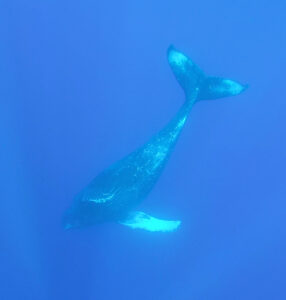Humpback Whale, Megaptera novaeangliae

 Humpback Whale, Megaptera novaeangliae. Underwater photographs taken in coastal waters off Kona, Hawaii, August 2014. Photography and identification courtesy of Bob Hillis, Ivins, Utah.
Humpback Whale, Megaptera novaeangliae. Underwater photographs taken in coastal waters off Kona, Hawaii, August 2014. Photography and identification courtesy of Bob Hillis, Ivins, Utah.
Phylogeny: The Humpback Whale is a member of the Balaenopteridae Family of Baleen or Rorqual Whales. The genus Megaptera is one of two genera in this family. There is only one species in this genus. The genus name Megaptera means giant wings, a reference to the whale’s large flippers. In Mexico this species is called Ballena Jorobada.
Morphology: Humpback Whales are large robust whales. The head and lower jaw have numerous rounded protuberances (tubercles). The flippers are very long, up to one-third the body length. The dorsal fin can vary from almost absent to high and falcate. The dorsal fin is located on a hump, which is particularly noticeable when the whale arches its back to dive. This is the origin of the name Humpback Whale. Humpback Whales have a black back and a black, white, or mottled underside. The flukes are black above. Each individual Humpback Whale has a different black and white color pattern on the underside of the flukes. This color pattern acts as a fingerprint in identifying individual animals. There is a line of tubercles running from the dorsal fin to the flukes. Female Humpback Whales are slightly larger than males, reaching 17 m (56 feet) in length and 40,000 kg (90,000 pounds) in weight.
Habitat and Distribution: Humpback Whales are generally found in coastal or continental shelf waters, though they do venture across deeper waters to reach islands and seamounts. These whales spend most of their time resting at the surface or diving to depths of less than 80 m (260 feet), though they can reach depths of 616 m (2020 feet). They are found worldwide. Humpback Whales are highly migratory, traveling up to 8000 km (5000 miles) from their feeding grounds in the high latitudes to their calving grounds in the tropics. In Mexican waters, Humpback Whales are found along the entirety of both coasts, though they are much more common along the Pacific coast.
Diet: As rorquals, Humpback Whales are gulp feeders. They gulp large quantities of sea water and then force it back out through their baleen plates. This filters out their food, including small fish, krill, copepods, and other plankton. Humpback Whales hunt cooperatively, blowing bubble nets that trap and concentrate prey species.
Predators: Orcas are the primary predator of Humpback Whales, especially juvenile Humpback Whales. White sharks, either alone or in packs, are also known to attack and kill Humpback Whales. When the whales are entangled in fishing gear, and exhausted or emaciated, they are most vulnerable.
Reproduction: As mammals, Humpback Whales reproduce sexually, with internal fertilization. Males compete with other males to reach females in estrus. Males and females will mate with multiple partners during the mating season. The gestation period is around 350 days. Mating and calving take place in the winter months. Females mate every other year. Calves suckle for up to a year, but start eating solid food around six months.
Ecosystem interactions: Humpback Whales are know to host ectoparasitic whale lice (cyamids), as well as internal parasites such as nematodes. Barnacles have a commensal relationship with Humpback Whales, with the whale providing the barnacle with structure and transportation. If the barnacles become a hindrance to the whale, the whales can exfoliate their skin against the sea floor or dislodge the barnacles by splashing or leaping. The Humpback Whale’s feeding method of using bubble nets concentrates prey which benefits multiple species of sea birds, with limited loss to the whales.
Human Interactions: Up until an international moratorium in the mid 1980’s, commercial whaling activities reduced the Humpback Whale population by 95%. Since that time many populations have been recovering well. Now, entanglement in fishing gear, vessel strikes, plastic pollution, and harassment from irresponsible whale watching activities, pose the greatest risks to Humpback Whale populations. Most involved countries still list Humpback Whales as either endangered or threatened. Populations in Oceania and the Arabian Sea are most critically endangered. From a conservation perspective the Humpback Whale is currently considered to be of Least Concern, due to their recovering populations.
Synonyms: Balaena allamack, Balaena atlanticus, Balaena boops, Balaena gibosa, Balaena lalandii, Balaena longamana, Balaena nodosa, Balaena novaeangliae, Balaena sulcata, Balenoptera antarctica, Balenoptera astrolabe, Balenoptera australis, Balenoptera capensis, Balenoptera leucopteron, Balenoptera syncondylus, Kyphobalaena keporkak, Megaptera americana, Megaptera antarctica, Megaptera bellicosa, Megaptera boops, Megaptera brasiliensis, Megaptera burmeisteri, Megaptera gigas, Megaptera indica, Megaptera kusira, Megaptera lalandii, Megaptera longimana, Megaptera longipinna, Megaptera nodosa, Megaptera novaezelandiae, Megaptera osphyia, Megaptera poescop, Megaptera versabilis, Poescopia lalandia, Rorqualus antarcticus, and Rorqualus australis.